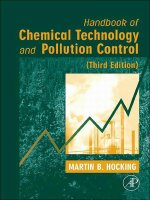- Trang chủ >>
- Khoa Học Tự Nhiên >>
- Vật lý
(Handbook of powder technology 1) c e capes particle size enlargement elsevier (1980)
Bạn đang xem bản rút gọn của tài liệu. Xem và tải ngay bản đầy đủ của tài liệu tại đây (5.21 MB, 205 trang )
PARTICLE SIZE
ENLARGEMENT
C.E. CAPES
National Research Council of Canada,
Ottawa, Canada
ELSEVIER SCIENTIFIC PUBLISHING COMPANY
Amsterdam - Oxford - New York
1980
PARTICLE SIZE ENLARGEMENT
www.pdfgrip.com
ELSEVIER SCIENTIFIC PUBLISHING COMPANY
335 Jan van Galenstraat
P.O. Box 2 1 1 , 1 0 0 0 AE Amsterdam, The Netherlands
© Elsevier Scientific Publishing Company, 1980
All rights reserved. No part of this publication may be reproduced, stored in a retrieval system or
transmitted in any form or by any means, electronic, mechanical, photocopying, recording or otherwise, without the prior written permission of the publisher, Elsevier Scientific Publishing Company,
P.O. Box 330, 1000 AH Amsterdam, The Netherlands.
Printed in The Netherlands
www.pdfgrip.com
HANDBOOK OF POWDER
TECHNOLOGY
Edited by J.C. WILLIAMS and T. ALLEN
School of Powder Technology, University of Bradford,
Bradford, West Yorkshire, England
Vol. 1
Particle Size Enlargement (C.E. Capes)
Vol. 2
Fundamentals of Gas-Particle Flow (G. Rudinger)
Vol. 3
Solid-Gas Separation (L. Svarovsky)
www.pdfgrip.com
HANDBOOK OF POWDER TECHNOLOGY
Edited by J.C. WILLIAMS and T. ALLEN
School of Powder Technology, University of Bradford, Bradford, West Yorkshire, England
The Handbook will present, in convenient form, existing knowledge in all specialized
areas of Powder Technology.
Information that can be used for the design of industrial processes involving the production, handling and processing of particulate materials so far does not exist in a form in
which it is readily accessible to design engineers. Scientists responsible for characterizing
particulate materials, specifying the requirements of industrial processes, operating plants,
or setting up quality-control tests all have similar problems in their fact-finding missions
through the scattered and scanty literature. The aim of this handbook is to remedy this
deficiency by providing a series of thematic volumes on various aspects of powder technology. Each volume is written as a monograph and can be used independently of other
volumes.
Emphasis will be placed on setting out the basic concepts of the subject and discussing
their applications to the design, selection and operation of equipment of an industrial
scale. To ensure timely publication, each volume will be published as soon as the material
has been delivered by the authors.
Titles published or in production:
Vol. 1: Particle Size Enlargement (C.E. Capes)
Vol. 2: Fundamentals of Gas-Particle Flow (G. Rudinger)
Vol. 3: Solid-Gas Separation (L. Svarovsky)
Forthcoming titles:
Particle Size Measurement (T. Allen)
Measurement of Surface and Pore Size of Solid Particles (T. Allen)
Filtration (A. Rushton)
Design of Solid Handling Plant (J.C. Williams)
Pneumatic Conveying of Solid Particles (J.S. Mason et al.)
Mixing and Segregation of Solid Particles (J.C. Williams and N. Harnby)
Mechanical Conveying of Solid Particles (H. Colijn)
Powder Coating (J.F. Hughes and S. Singh)
Dust Explosions (P. Field)
Fineparticle morphology (B.H. Kaye)
www.pdfgrip.com
EDITORS' PREFACE
This monograph on size enlargement of particles is the first of a series
which will together form a Handbook of Powder Technology, primarily
intended for engineers and scientists working in industry.
The scope of the Handbook can be defined as being concerned with that
part of chemical engineering which deals with processes involving the handling and treatment of material in solid particulate form.
Such a Handbook requires little justification. The characterisation and
behaviour of particulate systems are largely neglected in the education of
engineers and scientists. Courses in chemical engineering, in particular, are
almost entirely concerned with fluid systems, yet the graduate engineer or
scientist will frequently find that industry presents many problems in the
behaviour of particulate material for which his or her previous education has
given a quite inadequate preparation. The aim of the handbook is to remedy
this deficiency by providing monographs on various aspects of powder technology. It is also hoped that by providing suitable texts the teaching of
powder technology in universities and polytechnics will be encouraged.
Each monograph will be written by an expert in the particular aspect of
the subject covered and will be published as soon as it is prepared. This
avoids the problems associated with large multi-author books; the information will be available in a more convenient form and the up-dating of various
parts of the Handbook will be facilitated.
Comments and suggestions for improving the Handbook, as well as
proposals for further titles, would be welcomed by the Editors.
University of Bradford
March, 1980
J.C. Williams
T. Allen
www.pdfgrip.com
Vll
AUTHOR'S PREFACE
The methods used to create larger entities from fine particles so that the
bulk properties of particulates can be improved is the subject of this book.
These so-called "size enlargement" methods evidently concern a broad spectrum of technical disciplines and industries ranging from the relatively small
scale requirements of pharmaceutical manufacturers through the tonnage
requirements of the fertilizer and minerals processing industries.
A primary objective in preparing this book was to present a generalized
account of the many size enlargement techniques scattered throughout these
diverse industries, with emphasis on similarities and unifying characteristics
whenever possible. A related objective was to allow the reader to understand
the underlying principles so that successful techniques from other industries
can be adapted to the application of his particular concern.
This book is part of a series forming a Handbook of Powder Technology.
By definition, a handbook should be concise. To this end, information is presented in tables, diagrams and figures whenever possible. Descriptive text is
kept to the minimum felt to be necessary in understanding the subject with
emphasis on the equipment used and its operation.
In organizing this treatment, it was decided to devote one chapter to each
of the principal methods used to bring particles together into agglomerates,
viz.:
1. Agitation methods — tumbling agglomeration
2. Agitation methods — mixer agglomeration
3. Pressure methods
4. Thermal methods
5. Spray and dispersion methods
6. Agglomeration from liquids
These six topics, together with introductory material (Chapter 1) and considerations on agglomerate strength (Chapter 2) comprise the eight chapters
of the book. Readers looking for information on a specific size enlargement
technique can refer directly to the appropriate chapter. If the problem is to
find a suitable technique for a new application, however, a preliminary selection procedure is outlined in Chapter 1.
In preparing a concise account, it has often been necessary to delete theoretical background and other materials that would be included in a larger
book. By way of compensation, a quite comprehensive list of references has
www.pdfgrip.com
Vlll
been included with each chapter for readers wishing to obtain a greater
depth of knowledge.
At the time of writing, conversion from the Imperial (F.P.S) to metric system of units, especially in North America, is far from complete. Thus Imperial units have generally been used in the text with metric equivalents provided in brackets. In tables and figures, the system of units given in the
original source (usually Imperial) has been retained.
The author gratefully acknowledges the many individuals on the scientific,
technical, secretarial and librarial staff of the National Research Council of
Canada who assisted in and supported the preparation of this book.
The cooperation of those in industry and elsewhere who provided information for this handbook and/or allowed copyright material to be reproduced is also acknowledged. References to these sources are given in each
chapter.
Ottawa, Canada
January, 1980
C. Edward Capes
www.pdfgrip.com
IX
CONTENTS
Editors' Preface
v
Author's Preface
vii
Chapter 1. Introduction
1. Objectives of size enlargement
2. Historical perspective
3. Classification of methods and scope of the book
4. Selection of size enlargement methods
5. Literature of size enlargement
References
1
1
4
5
18
20
20
Chapter 2. Agglomerate bonding
1. Bonding mechanisms
2. Theoretical tensile strength of agglomerates
2.1. Particle assembly with localized bonding
2.2. Particle-particle bonds
2.3. Intermolecular and long-range bonds
2.4. Mobile liquid bonding
3. Strength testing
3.1. Tensile testing
3.2. Compressive testing
3.3. Other tests of agglomerate strength
4. Experimental aspects of agglomerate bonding
4.1. Tensile and compressive strengths
4.2. Typical agglomerate strengths
4.3. Binders and lubricants
4.4. Uniformity of bonding
4.5. Bond distribution and the size-strength relationship
References
23
23
25
25
26
27
28
32
32
34
35
36
36
38
40
43
46
49
Chapter 3. Agitation methods — tumbling agglomeration
1. Fundamental aspects
1.1. Agglomerate nucleation and growth
1.2. Influence of agglomerate strength: maximum feed particle size
1.3. Bridging liquid requirements
52
52
52
54
55
www.pdfgrip.com
1.4. Kinetics of growth
1.5. Agglomerate size distributions
2. Equipment
2.1. Inclined discs
2.1.1. Size classification effect
2.1.2. System and operating variables
2.1.3. Disc dimensions, speed, capacity and power
2.1 A. Modifications of the basic inclined discs
2.2. Drum agglomerators
2.2.1. Balling circuits and granulation loops
2.2.2. Drum dimensions, speed, capacity and power
2.2.3. Modifications of the basic drum agglomerator
2.3. Comparison of drums and inclined discs
References
59
63
63
64
65
66
67
69
73
75
77
79
80
81
Chapter 4. Agitation methods — mixer agglomeration
1. Horizontal pans
2. Pugmills
3. High speed shaft mixers
4. Powder blenders and mixers
5. Falling curtain agglomerators
6. Continuous flow mixing systems
References
83
83
84
86
88
92
93
96
Chapter 5. Pressure methods
1. The compaction process
1.1. Mechanism of compaction
1.2. Compaction aids
2. Equipment
2.1. Piston-type presses
2.2. Roll-type presses
2.2.1. Roll compaction and roll briquetting
2.2.2. Theoretical press design
2.2.3. Performance data
2.2.4. Ring roller presses
2.3. Extrusion presses
2.3.1. Piston-type extrusion presses
2.3.2. Roll-type extrusion presses
2.3.3. Screw-type extrusion presses
2.3.4. Screen granulators
References
97
97
97
99
100
100
102
102
102
109
109
112
113
115
117
119
122
Chapter 6. Thermal methods
1. Sintering and heat hardening (or induration)
123
123
www.pdfgrip.com
XI
1.1. Process mechanism and scope
1.2. Sintering equipment
1.2.1. Operating and design information
1.3. Heat hardening equipment
1.3.1. Shaft furnaces
1.3.2. Travelling grates
1.3.3. Grate kiln system
2. Nodulizing
3. Drying and solidification
3.1. Drum dryers and flakers
3.2. Endless belt systems
References
123
125
126
127
128
129
131
132
132
134
137
137
Chapter 7. Spray and dispersion methods
139
1. Spray drying
139
1.1. Spray dryer designs
141
1.2. Spray drying and size enlargement
143
2. Prilling
145
2.1. Design considerations
146
2.2. Tower size
148
3. Fluid bed spray granulation
149
3.1. Process description
150
3.2. System and operating variables; factors affecting product size 151
3.2.1. Liquid feed
152
3.2.2. Spray characteristics
152
3.2.3. Fluid bed conditions
152
3.2.4. Outlet gas conditions and recycle of fines
152
3.3. Design and performance information
153
4. Spouted bed granulation
156
5. Pneumatic conveying or flash drying
158
References
160
Chapter 8. Agglomeration in liquid media
1. Introduction
2. Agglomeration by immiscible liquid wetting
2.1. General characteristics
2.1.1. Removal of fine particles from liquids
2.1.2. Pelletization and sphere formation
2.1.3. Selective agglomeration
2.2. Processes and equipment
3. Agglomeration by polymeric flocculants
4. Dispersion in liquid phase
www.pdfgrip.com
t
161
161
161
162
163
163
163
164
170
174
Xll
Appendix. List of suppliers of size enlargement equipment
177
Author Index
181
Subject Index
187
www.pdfgrip.com
Chapter 1
INTRODUCTION
In the broadest sense, size enlargement can be defined as any process in
which small particles are formed into larger entities. Size enlargement is
used to improve the usefulness of fine materials either in a downstream processing step or as a final product agglomerate. As discussed in Section 1
below, there are many specific reasons for doing size enlargement depending
on the product and/or industry under discussion.
Most often the starting material for size enlargement is fine particles and
the product is agglomerates or aggregates in which the original particles can
still be identified. This is not always the case, however, since granular freeflowing solids may result from the drying or cooling of concentrated slurries
or melts in which amorphous or crystalline masses are formed from the feed
particles. Such processes are included as size enlargement techniques in the
present treatment. In addition, it is often considered that the products of
size enlargement should be permanent masses and indeed methods to produce permanent bonding (e.g. heat induration of mineral agglomerates) are
discussed in Chapter 6. This criterion is not entirely satisfactory in that the
bonding necessary in a given application may be quite weak and transient;
agglomerate strength need only be sufficient for the products to meet downstream requirements. Thus relatively weak powder clusters suffice for instantized food products and in the preparation of powders for tableting. It
should also be noted that size enlargement may be only a secondary result in
some processes where granular materials are produced. The primary objective
may be, for example, drying (as in spray and flash drying) or disposal of
waste (as in fluid bed incineration). A number of such peripheral methods
are included here with emphasis, of course, on the size enlargement aspects.
1. Objectives of size enlargement [1—3]
Size enlargement processes are used in many industries today with the
desired results depending on the particular application. In each case, however, the substitution of granular material for fine powders yields a number
of beneficial effects. The benefits and objectives of size enlargement, together
with some examples of their application, may be summarized as follows:
1. Production of useful structural forms and shapes, as in the pressing of
intricate shapes in powder metallurgy or the manufacture of spheres by
planetary rolling.
www.pdfgrip.com
TABLE 1.1
Historical development of size enlargement methods
Early usage
Ceramics
Powder metallurgy
Medicinal and
pharmaceutical
Glassmaking, pottery
forming, preparation of
clay building materials
in antiquity.
Ancient technique of
hammering sponge iron
into implements. Precious metal objects
formed from powder.
Solid molded forms containing medicinal ingredients can be traced
back at least 1000 years.
Platinum powder compaction, followed by
heating and hot forging
to shape.
1800
Development of mechanized forming methods
essentially the same as
modern techniques.
1850
Industrial compaction,
sintering and working
of powders (especially
tungsten) for incandescent filaments.
Expansion of iron and
copper parts from powder; related to mass
production in automotive industry, WWII,
etc.
1900
1950
Development of nonsilicate ceramics with
electronic, nuclear and
space applications.
Growth of materials
science, composite
materials.
www.pdfgrip.com
Development of medicinal tablets by die compaction of powders.
Early single punch and
rotary tablet machines
in use.
Design of both rotary
and reciprocating tablet
machines became welldefined.
Output rates of tablets
increased. Improvements in physical and
chemical characteristics
of compressed tablets.
Research and improvements in functional
aspects (disintegration,
dissolution).
Coke, coal and
other fuels
Minerals processing
Fertilizers
Chemical, food and
other industries
Coal carbonization
developed to yield
coke (coal agglomerates) and byproducts.
Large scale production of pressed coal
blocks from coal
fines and pitch binders.
Binderless briquetting of lignite, peat,
etc. Development of
roll and extrusion
presses for fuels.
Development of
formed coke technology, based on
coal agglomerates.
Batch sintering to
handle fines included
roast heaps, blast
roasting pots.
Molding of rubber
and resinous compositions.
Iron ore briquetted
and fired.
Continuous sintering
of fine ore and dusts.
Burden preparation
in tumbling drums.
First commercial
iron ore pelletizing
plants in operation.
Dramatic increases
in plant capacity.
Early development
of granular nitrogen
fertilizers usually
based on rotary
dryer.
Granulation of mixed
fertilizers widely
adopted in U.K. before 1950.
After 1950, a major
swing to granular
mixed fertilizers in
U.S.
www.pdfgrip.com
Hot molding of thermosetting plastics.
Pelleting of carbon
black.
"Instant" agglomerated foods (e.g.
milk powder) developed.
2. Provision of definite quantity units for metering, dispensing and administering, as in pharmaceutical tablets.
3. Reduction of dusting losses, as in the briquetting of waste fines.
4. Creation of non-segregating blends of particulates, as in the sintering of
fines in the steel industry.
5. Improved product appearance, as in the manufacture of fuel briquets.
6. Reduced caking and lump formation, as in the granulation of fertilizers.
7. Improved flow properties, as in the granulation of ceramic clay for
press feed.
8. Increased bulk density with improved storage and shipping properties,
as in the pelleting of carbon black.
9. Decreased handling hazards, especially with irritating or obnoxious
powders, as in the flaking of caustic.
10. Control of solubility, as in "instant" food products.
11. Control of porosity and surface-to-volume ratio, as in the pelleting of
catalyst supports.
12. Improvement in heat transfer, as in the agglomeration of ores and glass
batch for furnace feed.
13. Separation of multicomponent mixtures, as in selective agglomeration
of the combustible matter in coal.
14. Removal of particles from liquids, as in the formation of pellet-like
floes from clay in water by the use of polymeric bridging agents.
2. Historical perspective [1,3—18]
Table 1.1 summarizes the major developments in size enlargement processes that have taken place over the past 200 years. Related techniques can
be traced to forming processes used in antiquity, including the preparation
of building materials such as bricks and tiles, the forming of solid objects
from sponge metal by hammering and the administering of medicinal compounds in various solid forms. Agglomeration became established as a relatively large-scale practical operation during the industrialization of the 19th
century with the need to beneficiate and process fine coals and ores. Size
enlargement became a basic step in many industrial processes in the first part
of this century and has enjoyed particularly rapid expansion in the last thirty
years. Some of the factors that have contributed to this growth are:
a. Intensive agriculture and the use of high analysis nitrogen fertilizers
which cake badly in non-granular form.
b. Reduction in the quality of resources and the necessity for grinding to
liberate impurities followed by agglomeration of the upgraded material.
c. Environmental factors, including the disposal of recovered dusts and
the substitution of coarser furnace feeds to avoid airborne fines and fumes.
www.pdfgrip.com
d. The use of automated high-volume processing requiring consistent feeds
with good flow properties.
e. A modern trend to instant or convenience food products.
3. Classification of methods and scope of book
Methods to create larger entities from fine particles may be broadly classified into two main categories [1]. On the one hand are the forming-type processes in which the properties of the individual agglomerates (such as shape,
size, composition, density, etc.) are carefully controlled. On the other hand
are the size enlargement methods in which a coarser granular material is
created from fine powders. The properties of the bulk material are controlled
in this case and the characteristics of the individual agglomerates are important only insofar as they affect the properties of the whole or bulk product.
As a result of these differences, the forming-type methods are usually of low
capacity, often measured in pieces/hour, while the methods to beneficiate
bulk material are of much larger capacity, usually measured in tons/hour.
As seen in Table 1.1, forming methods using fine powder feeds have been
practised for centuries in the preparation of such products as tiles, bricks and
tablets. Brief descriptions of modern forming methods used mainly in the
pharmaceutical, powder metallurgy and ceramics fields are given in Table 1.2.
Such forming methods are generally outside the scope of the present treatment. Information on these techniques is well documented elsewhere; the
reader is directed to the references noted in Table 1.2.
Size enlargement to improve the bulk properties of particulates is the subject of this book. Techniques to accomplish this beneficiation may be classified according to the principal method used to bring particles together into
agglomerates. The categories used here are:
1. Agitation methods — tumbling agglomeration
2. Agitation methods — mixer agglomeration
3. Pressure methods
4. Thermal methods
5. Spray and dispersion methods
6. Agglomeration from liquids
The methods available in each of these categories are briefly described in
Table 1.3 together with an indication of the equipment used, capacity range,
agglomerate characteristics and some of the advantages and limitations of
each. Full details are given later in the book where a chapter is devoted to
each major category of methods. Table 1.4 summarizes the areas of application for the various size enlargement methods.
Of course, in any classification system areas of overlap are unavoidable.
Some size enlargement processes involve more than one agglomeration mechanism. For example, thermal after-treatment is quite common to harden
www.pdfgrip.com
TABLE 1.2
Forming-type methods; properties of individual compacts are controlled
Method
Description
Other names
Equipment
1. Fine powders, held together
by capillary forces of liquid
binder, grow into spheres under
rolling collisional forces.
Spheroidization,
spherical agglomeration
Modified planetary
mill, various
shaking devices
2. Fine powders formed into
plastic mass with aid of liquids
and binders, extruded into
pellets which are rolled into
spheres.
Pill making,
spheronisation
Automatic pill
machines,
"Marumerizer"
1. Powders compressed within
die cavity into cylindrical or
other simple shapes by action
of punch.
Tableting, powder
pressing, dry pressing, hot pressing
Tablet machines,
powder presses.
2. Powders compressed into
more complex shapes with
special dies and plungers.
Compression
molding, powder
pressing, dry pressing, damp pressing, hot pressing
Powder presses,
molding presses
Isostatic compaction
Powder encased in flexible mold
is pressed equally from all directions by pressure transmitted to
the mold by a liquid medium.
Isostatic molding,
isostatic pressing
Hydrostatic molding chambers,
automatic isostatic presses
High energy rate
compaction
Powders subjected to extremely
high pressures instantaneously
to form compacts.
High energy rate
forming (HERF),
explosive forming
Roll pressing
Powders compacted by squeezing between two rolls.
Powder rolling,
roll compaction
High velocity
presses, impact
presses, explosive
rams.
Roll presses
Extrusion
Stiff plastic particle mix is
pushed through a die orifice to
form a continuous compact
which may be cut to desired
length.
Agitation methods
Planetary rolling
and/or shaking
Vibratory compaction
Pressure methods
Unidirectional
compaction
Vibration is applied to a mass of
powder in a container-mold so
that the particles seek a state of
closest packing. Part subsequently strengthened, e.g. by
sintering.
www.pdfgrip.com
Vacuum auger,
screw extruder,
plunger press,
piston extrusion
apparatus
Capacity
Advantages, limitations, comments
References
Batch process generally
using less than 0.5 kg
per batch.
High energy input yields more uniform size, greater
sphericity and density than other agitation methods.
Less waste than pressing-sintering-grinding method.
Sphere size generally 0.1 mm to 5 mm.
19,20,21
Batch process; can produce 200 to 2000 kg
per hour.
9,22
Size distribution, shape, etc. of particles must be
controlled for maximum density. May be used to obtain more uniform density distribution in complicated
shapes.
23
Single-punch machines,
up to 200 pieces/min;
Rotary machines, up to
2000 pieces/min; High
speed machine up to
about 10,000 pieces/
min.
Materials should have good flow characteristics and
cohesive properties. Feed preparation, binder, lubricants used to meet requirements. Can produce compacts of simple shape with controlled properties at
high rates.
9, 24, 25
In powder metallurgy,
rate may range from 5
parts/min to 25 parts/
min.
Non-uniform pressure distribution in compact limits
aspect ratio of parts. Can be improved by pressing from
top and bottom, rather than from one direction only.
Tooling cost relatively high but powder pressing often
more economical than other methods.
5, 7
About 1000 to 1500
pieces per hour with
automatic presses.
Compacts with uniform properties (e.g. density,
shrinkage) are formed. Wider dimensional tolerances
than with unidirectional compaction are required.
Complex and large shapes are possible. Lubricants not
required.
26
Can produce very large structural shapes. Used with
powders requiring high pressures to produce compacts
of special properties.
5
High capacity strip-forming process.
27
Particulates must be capable of forming a plastic mass
with liquid. Plasticizers may be used to accomplish
this. Compact shape must have an axis normal to a
fixed cross section.
12,28
Dense compacts can be formed rapidly and economically at low pressures. Piston system operates at
higher pressure than auger and can produce more
precise compacts. Less precise, however, than closed
die compaction.
www.pdfgrip.com
TABLE 1.2
(continued)
Method
Thermal methods
Sintering
Miscellaneous
Soft plastic
forming
Forming from
suspension
Description
Other names
Equipment
1. Strengthening of compacts by
heat treatment through bonding
of particles by molecular (or
atomic) attraction in the solid
state. Attendant processes
include partial fusion, densification, recrystallization and/or
chemical reaction.
Firing
Kilns, Furnaces
2. Powdered polymer fused at
inner surface of hot hollow
mold, excess powder poured
out and remainder completely
fused in oven. Hollow article
removed from mold after
cooling.
Powder molding
Ovens
Hand molding
Ramming
Potter's wheel
Pneumatic tamping tools, mold.
Revolving mold,
profile tool.
methods
1. Sufficient water is added to
clay body to form a soft plastic
mass which is readily worked at
low pressures.
Jiggering
2. Suitable pharmaceutical formulations are mixed to a plastic
mass using solvent and/or moistening agents, forced into a mold,
pushed out and dried.
Tablet molding
1. Stable suspension of particles
is poured into porous mold
(plaster of Paris) and solid particles are deposited as water is
absorbed by mold.
Slip casting
2. Dispersion of finely divided
poly (vinyl chloride) in liquid
plasticizer poured into mold
which is heated to 350—400° F
to form fused solid on interior
of mold.
Slush molding
Hand molding,
automatic tablet
molding machines
* May also include simultaneous heating to yield superior compacts of higher density,
finer grain size, close dimensional tolerance, etc.
www.pdfgrip.com
Capacity
Advantages, limitations, comments
Common final treatment for ceramic and metallic compacts. Sintering treatment normally occurs below melting point of powder material.
References
5,23
Used to form large pipe sections and tanks from
polyethylene.
Not a precise forming method. Jiggering requires
shapes with symmetrical circular cross sections.
About 2500/minute
for automatic equipment
12, 28
Molded tablets are generally softer and more readily
soluble than compressed tablets.
Objects formed can be solid or hollow of controlled
wall thickness. Suitable for complex shapes and large
parts. Cost of molds is low.
www.pdfgrip.com
12,28
10
TABLE 1.3
Methods to improve properties of bulk powders by particle size enlargement
Description
Other names
Equipment
Tumbling agglomeration
Powders, usually in the presence
of a liquid binder, are subjected
to a rolling cascading action to
form agglomerate nuclei which
grow by coalescence and/or
layering of fines.
Granulation,
balling, wet pelletization, pelletization, pelleting
Drums, inclined
discs, cones, pans,
bowl and plate
granulators, "Flying Saucer"
Mixer agglomeration
Moist, plastic particles are
mixed and "fluffed" to a nodular texture by the action of
(usually) twinshaft agitators in
a horizontal cylindrical vessel.
Granulation, wet
pelletizing
Horizontal pan,
pugmill, drum
pugmill, blunger,
peg granulator,
pin mixer
Powder clustering
Powders are superficially moistened (often at less than 5% water or liquid binder using spray,
steam, mist, etc.) during agitation to form fine agglomerates.
Granulation,
instantizing
Powder blenders
(conical, vertical
shaft, ribbon),
falling curtain
agglomerators
(drum, vibrating
feeder), continuous flow jet mixing systems
1. Large briquets formed (e.g.
from scrap metal turnings) by
piston compression into die.
2. Vibration and limited ram
pressure consolidate granular
material in molds of various
sizes and designs.
Briquetting,
compacting,
preforming
Briquetting,
compacting,
molding
Heavy duty compacting presses
3. Powders compressed into
flat-faced tablets by action of
punch and die, comminuted
and screened to form feed for
final compression.
Dry granulation,
slugging, pre-compression
Heavy duty
tableting press
1. Particulate material, with
or without binder, is compacted
by squeezing as it is carried into
the gap between two rolls rotating at equal speed
Briquetting, roll
compacting
Compacting rolls
with smooth, corrugated or
pocketed surfaces
Method
Agitation methods
Pressure methods
Unidirectional,
piston-type compaction
Roll pressing
www.pdfgrip.com
Table presses,
concrete block
and brick machinery
11
Typical capacity
per machine
Advantages, limitations, comments
Up to 100 tons/hr
for iron ore balls;
200 tons/hr or
more for sinter
preparation; 50
tons/hr for fertilizer granulation.
Ball-shaped agglomerates only can be formed. Diameters from about 1/8
in. are normally produced. Larger balls require very fine feed (e.g. 80%
minus 44 /zm) although much coarser feeds can be used for smaller product.
Rather weak agglomerates are formed; must be further strengthened e.g.
by drying or firing. Rotary drums and inclined discs are most common.
Discs yield more uniformly-sized product and require less space. Drums are
less sensitive to changes in feed and are more suited to simultaneous treatment of charge (e.g. drying, ammoniation) as in fertilizers.
Generally less
than 10-15 tons/
hr, but much larger units are in use
(e.g. 350 tons/hr
fertilizer blunger,
300 tons/hr drum
pugmill for sinter
preparation)
Positive "cutting-out" action allows plastic and sticky masses to be treated.
Kneading action claimed to produce denser, stronger granules. Less plasticizing liquid phase required than with tumbling agglomeration. For plastic
material, less power cost than extrusion. Irregular agglomerates may be
formed, requiring finishing by tumbling, e.g. in dryer. Product size distribution wide, requires high recycle. With very fine powders, capable of forming
micropellets e.g. finer than 10 mesh. Upper size usually less than 5-6 mm.
Agitator wear must be considered.
Generally less
than 10 tons/hr,
but units up to
about 50 tons/hr,
also available.
Used to produce small (less than 2 mm), irregular, relatively weak agglomerates with fast dissolving and wetting properties. Generally not suitable
for materials which go through a plastic or sticky stage. Blending equipment yields good uniformity. Jet-mizing systems require well-mixed feed
but are capable or larger throughputs.
Less than 5 tons/
hr
Briquets may be 5 in. dia. X 3 in. thick. Simple operation. Not suited to
large tonnages. Reciprocating nature involves non-uniform loads on drive
motors.
Relatively larger agglomerates formed than in most other methods. Limited pressure necessitates binder for adequate final strength.
50 tons/hr quoted
for iron fines
Related to tableting operation
"Slugs" or preforms are usually 1 to 2 in. diameter in pharmaceutical
manufacture. Suited to granulation of moisture-sensitive materials and
those unable to withstand high temperature of drying in wet granulation
methods.
5 to 30 tons/hr
for industrial
chemicals, generally up to 50
tons/hr; some
machines up to
100 tons/hr.
Probably most versatile tonnage method of size enlargement. Most materials can now be agglomerated with aid of binders, heat and/or very high
pressures if needed. Many shapes are possible in compacts, but fine detail
of tablets lacking. Flashing or web on compact may be objectionable.
Sheet can be formed with smooth or corrugated rolls and subsequently
broken down to granular product. Principal operating costs related to roll
replacement (due to abrasion) and power consumption.
www.pdfgrip.com
12
TABLE 1.3 (continued)
Description
Other names
Equipment
2. Material is compacted as it is
carried into the gap between a
molding groove on the inner
circumference of a ring and a
press wheel of smaller diameter running in the groove.
As above
Ring roller presses
1. Powders are intimately mixed
to a plastic state and pushed
through an orifice to form
compact.
Pelleting,
pelletizing,
plasticizing,
granulation
2. Granulation of moist mix by
forcing it through a mesh screen
or plate through action of wiper
mechanism.
Granulation,
sifting
Piston extrusion
presses, roll
extrusion presses,
pellet mills, screw
extruders, plasticizing pans
Screen or sieve
granulators
Feed of ore fines, pulverized
fuel, waste dusts and flux is
moistened, mixed to a nodular
texture and ignited on a horizontal grate to form an
agglomerated sinter cake.
Sintering
Continuous sinter
strand (travelling
grate)
Pelletizing (cf.
"tumbling
agglomeration")
Green balls or pellets of ore
or minerals are hardened by heat
treatment with attendant loss
of moisture and volatile matter.
Pellet induration,
pellet firing
Travelling grate,
rotary kiln, vertical
shaft furnace
Nodulizing
Mixture of ore fines and fuel,
or simply of fusible fines, is
passed through a rotary kiln
or dryer and agglomerates
form by partial fusion, chemical
reaction, etc. as the temperature
is raised
Granulation,
calcining
Rotary kiln, dryer
Drying and
soldification
1. Plastic masses and pastes
are preformed into wet
agglomerates of consistent size
by extrusion or granulation
(cf. "pressure methods") prior
to drying and hardening in
various types of dryers.
Granulation,
pelleting, drying
Various preforming devices
(extruders,
granulators)
followed by
dryers
2. Pastes and melts are spread
as a thin film on a surface
where they are dried and cooled,
respectively. Subsequently
scraped off to yield solid product.
Drum drying,
flaking, melt
cooling, endless
belt processing,
slating, pastille
formation.
Drum dryers,
drum flakers,
endless belt
systems
Method
Extrusion
Thermal methods
Sinter formation
www.pdfgrip.com
13
Typical capacity
per machine
Advantages, limitations, comments
Generally less than Press wheel may contain projections to form briquets from compressed
5 tons/hr
strip. Pressure build-up and release more gradual than in roll press, claimed
to avoid crack formation in agglomerates. Capacity of largest machines
machines much less than for roll presses.
Up to 25-30 tons/
hr or more
Depends on mix
consistency, screen
mesh size and
wiper speed,
probably a few
tons/hr.
Cylindrical pellets formed by cutting with knife as extrudate leaves die.
"Spaghetti" form also produced, as in wet granulation of pharmaceutical
mixes by extrusion through orifice plate. Plastic mix formed by shearing,
mixing action prior to extrusion. Binders, plasticizing agents, lubricants
may be used. Relatively low pressure method particularly suited to sticky,
cohesive materials.
Relatively low cost, simple granulation method.
Up to about 1000
tons/hr or more
Sinter is more irregular and cannot withstand handling as well as pellets.
Hence, generally located at smelter where is is well suited to utilization of
waste materials. Can use relatively coarser feed than pelletizing.
Up to about 1000
tons/hr or more
Process developed to utilize very fine concentrates of low grade ores.
Uniform size, spheroidal shape, abrasion resistance and strength well suited
to long distance shipping from mine to smelter.
50 tons/hr
Formation of rings of fused material inside kiln is a problem. Technique
can be used with fusible fertilizer formulations to granulate at low
moisture levels. May not be suitable for materials which decompose on
heating or if melting point too high.
Dependes on preforming method
used.
Method simultaneously dries and granulates plastic masses such as pastes
and filter cakes. Selection of best preforming method and dryer depends
on experience and suitable tests.
A few 1000 lb/hr,
up to 20 or 30
tons/hr.
A versatile system to handle a wide range of feed materials, capacities and
product forms. Useful for heat-sensitive materials.
www.pdfgrip.com









